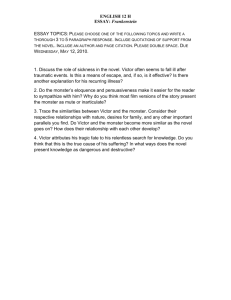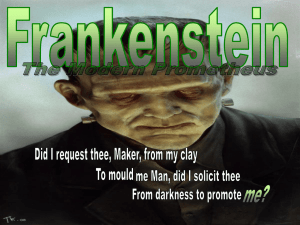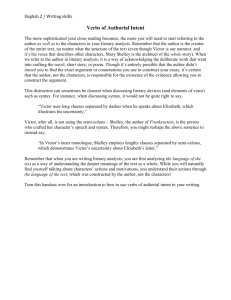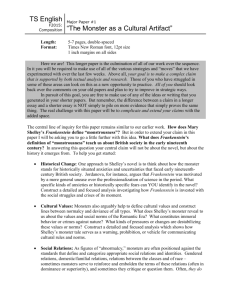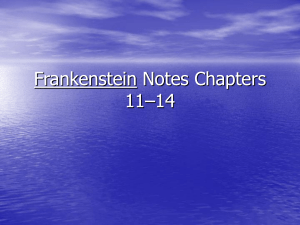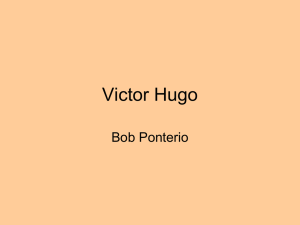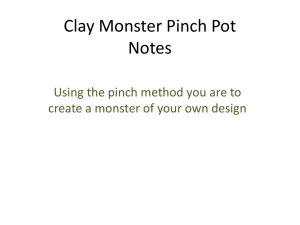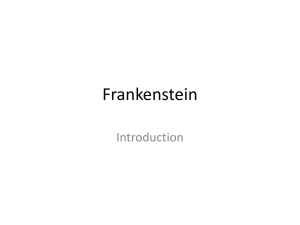Kempinski Jennifer Kempinski Professor Pamela Covert ENL 2002
advertisement
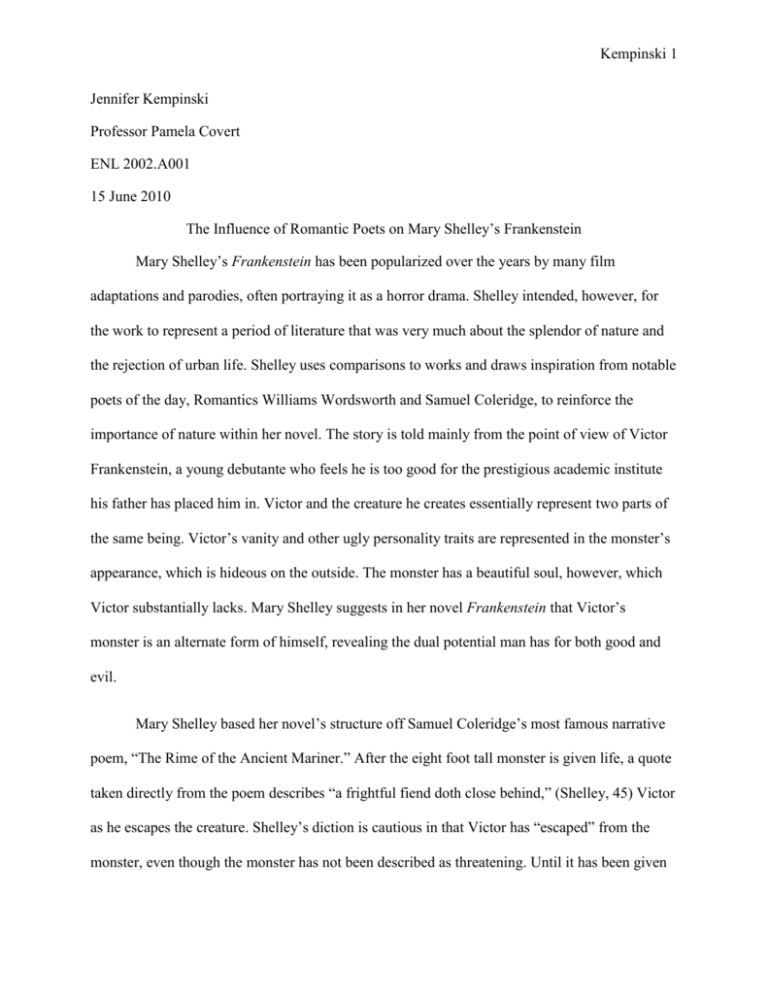
Kempinski 1 Jennifer Kempinski Professor Pamela Covert ENL 2002.A001 15 June 2010 The Influence of Romantic Poets on Mary Shelley’s Frankenstein Mary Shelley’s Frankenstein has been popularized over the years by many film adaptations and parodies, often portraying it as a horror drama. Shelley intended, however, for the work to represent a period of literature that was very much about the splendor of nature and the rejection of urban life. Shelley uses comparisons to works and draws inspiration from notable poets of the day, Romantics Williams Wordsworth and Samuel Coleridge, to reinforce the importance of nature within her novel. The story is told mainly from the point of view of Victor Frankenstein, a young debutante who feels he is too good for the prestigious academic institute his father has placed him in. Victor and the creature he creates essentially represent two parts of the same being. Victor’s vanity and other ugly personality traits are represented in the monster’s appearance, which is hideous on the outside. The monster has a beautiful soul, however, which Victor substantially lacks. Mary Shelley suggests in her novel Frankenstein that Victor’s monster is an alternate form of himself, revealing the dual potential man has for both good and evil. Mary Shelley based her novel’s structure off Samuel Coleridge’s most famous narrative poem, “The Rime of the Ancient Mariner.” After the eight foot tall monster is given life, a quote taken directly from the poem describes “a frightful fiend doth close behind,” (Shelley, 45) Victor as he escapes the creature. Shelley’s diction is cautious in that Victor has “escaped” from the monster, even though the monster has not been described as threatening. Until it has been given Kempinski 2 life, Victor has not realized how ugly the monster was, even though he was the one putting it together. Once it is alive, however, it becomes a living being, the alter ego of Victor himself. Victor poured his vanity and selfishness into the creation of the monster, along with all of his other vices. The monster’s appearance reflects Victor’s crudely deformed personality. Victor, frightened and disgusted by the monster’s appearance, a true look at how ugly his soul is, runs away. The quote “a frightful fiend doth close behind” references the symbol of the albatross in Coleridge’s poem, also “a frightful fiend.” After the mariner shoots the albatross, his crime against nature becomes a burden on the mariner. He wallows in guilt with the “fiend close behind” for his sin. The albatross’s murder is akin to Victor’s crime against nature he commits when he takes creating life into his own hands and makes the monster. The Romantic period of literature was just as much a movement of respecting nature as it was a theory that man is not inherently born evil, but that he possesses the ability to become evil throughout his life. Victor distinctly regrets creating the monster, but what he may not realize is his repulsion is at the revelation of how ugly, and evil, he truly is on the inside when he gazes upon the monster. Williams Wordsworth, as a critical player in the Romantic movement of English literature, supported the notion that man has the potential to be cruel and ugly on the inside, though he is not born with an inherent propensity towards such a disposition. One can conclude from his poem “The World Is Too Much with Us,” that Wordsworth would have empathized with Victor’s creation, and likely thought of Victor as the “monster.” Victor, too much with “the world,” has acquired an evil personality when he gets caught up in his own ambition to create life himself. The monster is not born an ugly, or evil, being on the inside. The murders he commits throughout the novel are an act of violence caused only because he was first rejected by his creator, and then by all other humans. Shelley provides evidence that the monster Kempinski 3 would have been less violent if he was treated with respect, for instance the fact that he reads the novel Paradise Lost and gently observes the cottagers next door for a year, learning their language. In the poem, Wordsworth’s attitude is conveyed as bitter and caustic towards the world of man, which Victor represents, but respectful and reverent of the natural one, which is symbolized by the monster. He explains how the beautiful features of nature are “now like sleeping flowers” because as of late, man is blind to this beauty, just as Victor was blind to the beauty within his monster. Victor focused only on the outward appearance of his “hideous” creation, just as he focused only on the ambitions within his own heart. Victor’s soul can easily be matched with the appearance of the creature, just as the creature’s soul can be matched to Victor’s normal, human, possibly attractive appearance. Wordsworth references a radical form of spirituality is his argument. He argues that even “Pagans” are happier than the common man. As worshippers of nature, they are better off than worshippers of manmade creations, just as Victor was planning to worship himself over the completion of his monster, should it have been what he deemed successful. Mary Shelley uses her own symbols within the novel to convey the idea that the monster appearance represents Victor’s heart. During Victor’s journey to England to begin work on the creature’s only request of him, to make him a female to keep him company, he passes many “ruined castles” (Shelley, 143) among other nucleic landscapes. The castle represents man’s creations, perhaps Frankenstein’s monster himself. Though castles can be beautiful, and productive, Shelley’s castles appear “ruined,” cluttering the landscape. Shelley suggests man can create to better themselves within reason, but since the castles have not been cared for, they fall into the category of needless construction the Romantics are protesting. The castles had the potential to flourish, but now have gone to waste. Similarly, the creature once had the potential Kempinski 4 to be a kind and productive member of society, but now is a murderer as a product of his environment. Victor made his monster as a product of Victor’s love for himself. The creation is a crime against nature, which is the milieu for Coleridge’s “The Rime of the Ancient Mariner.” If Victor can be compared to God for creating his very own being, then there is evidence to support Wordsworth’s claim that being a “Pagan” is better than being a slave to innovation and man’s ambitions. Both of these poems along with Shelley’s novel represent ideals of the Romantic era of poetry, that man is not born evil, but has the potential to become evil over time, and that nature should be respected by men, who are vulnerable to selfishness and ugliness of character. Mary Shelley suggests in her novel Frankenstein that Victor’s monster represents how ugly Victor would be if he was physical manifestation of his personality. Kempinski 5 Works Cited Coleridge, Samuel Taylor. “The Rime of the Ancient Mariner.” Online-literature.com. The Literature Network. Web. 15 June 2010. Shelley, Mary Wollstonecraft. Frankenstein. Irvine, CA: Saddleback Pub., 2006. Print. Wordsworth, William. “The World Is Too Much with Us.” Http://www.wsu.edu/. Washington State University, 23 Dec. 1998. Web. 15 June 2010.
